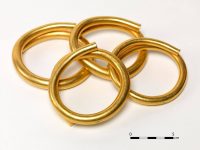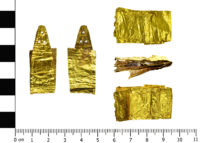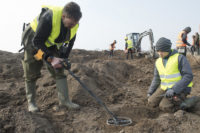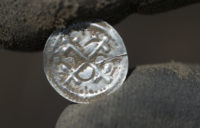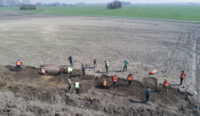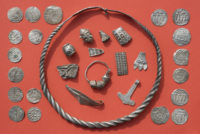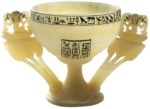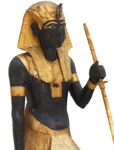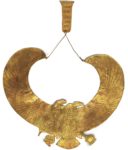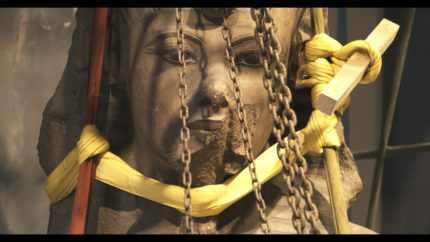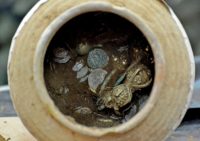 An excavation of the Kaliakra Fortress on the coast of the Black Sea in northern Bulgaria has unearthed a small clay pot full of coins, jewelry and other valuables hidden under a floor in the Middle Ages. A team of archaeologists headed by Bonnie Petrunova, director of the National History Museum (NHM) in Sofia, discovered the pot on August 17th, 2018, in a room that was burned in the 14th century, conveniently providing the outside date range for the burial of the hoard.
An excavation of the Kaliakra Fortress on the coast of the Black Sea in northern Bulgaria has unearthed a small clay pot full of coins, jewelry and other valuables hidden under a floor in the Middle Ages. A team of archaeologists headed by Bonnie Petrunova, director of the National History Museum (NHM) in Sofia, discovered the pot on August 17th, 2018, in a room that was burned in the 14th century, conveniently providing the outside date range for the burial of the hoard.
The pot, filled with soil as well as treasure, was moved to the NHM to be excavated in laboratory conditions. After painstaking removal of the soil, archaeologists found a total of 957 objects: 873 gold and silver coins, 11 fittings and buckles, 28 silver and bronze buttons, 11 gold earrings, one gold ring, a second metal ring and four gold beads studded with gems.
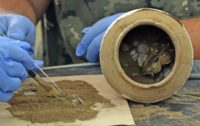 The coins include both Ottoman and Bulgarian silver issues. A majority of them, about 60% of them are Ottoman. Most of that 60% date to the reign of Sultan Bayazid Yildirum (1389-1402). A fraction of them are older, dating to the reign of his predecessor Murad I (1362-1389). Of the Bulgarian coins, 25% were minted under the reign of Ivan Alexander (1331-1371). They are very small, a symptom of the economic crisis in Bulgaria at the time. There are nine coins minted in Vidin by governor John Sratsimir. A few Byzantine silver pieces are also in the mix, including several very rare hyperpyroni.
The coins include both Ottoman and Bulgarian silver issues. A majority of them, about 60% of them are Ottoman. Most of that 60% date to the reign of Sultan Bayazid Yildirum (1389-1402). A fraction of them are older, dating to the reign of his predecessor Murad I (1362-1389). Of the Bulgarian coins, 25% were minted under the reign of Ivan Alexander (1331-1371). They are very small, a symptom of the economic crisis in Bulgaria at the time. There are nine coins minted in Vidin by governor John Sratsimir. A few Byzantine silver pieces are also in the mix, including several very rare hyperpyroni.
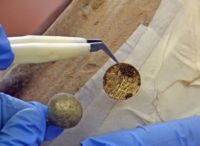 The gold coins, much fewer in number, include 20 gold hyperpyroni of the Byzantine Empire, one the last gold coins issued of the empire. They are so debased and flimsy that it’s hard to identify them. Experts have been able to spot John V Palaiologos and his mother Anna of Savoy (regent during the minority of her son from 1341 until 1347), John VII Palaiologos, Andronikos II Palaiologos and Andronikos III Palaiologos on the obverse of some of them. There are also eight high quality Venetian gold coins, the classic Zecchino d’Oro, each made of 3.5 grams of 24-carat gold. Most of them were issued by Doges Marco Cornaro (1365-1368) and Andrea Dandolo (1343-1354).
The gold coins, much fewer in number, include 20 gold hyperpyroni of the Byzantine Empire, one the last gold coins issued of the empire. They are so debased and flimsy that it’s hard to identify them. Experts have been able to spot John V Palaiologos and his mother Anna of Savoy (regent during the minority of her son from 1341 until 1347), John VII Palaiologos, Andronikos II Palaiologos and Andronikos III Palaiologos on the obverse of some of them. There are also eight high quality Venetian gold coins, the classic Zecchino d’Oro, each made of 3.5 grams of 24-carat gold. Most of them were issued by Doges Marco Cornaro (1365-1368) and Andrea Dandolo (1343-1354).
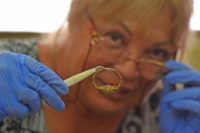 The date range of the coins coincides with the evidence of the torching of the space to confirm the treasure pot was hidden under the floorboards at the end of the 14th century, a turbulent period in the history of the fortress who political fortunes are reflected in the coinage. The area was part of the Despotate of Dobruja, an autonomous principality in the fractured Bulgarian Empire. Under the control of Dobrotitsa, who gave himself the title “Despot,” the principality achieved its greatest power and territorial extent. Dobrotitsa made Kaliakra his capital and deployed his navy on the Black Sea in alliance with Venice against Genoa. He fought Murad I, who by the end of his reign would conquer much of modern-day Bulgaria. Dobrotitsa’s son Ivanko changed his father’s policy as soon as he ascended the throne in 1386, signing a peace agreement with the Ottoman sultan, another with Genoa and moving the capital from Kaliakra to Varna. The changes did not lead to stability and in 1388 Ivanko was killed fighting the Ottomans at Varna. Mircea I of Wallachia stepped into the vacuum of power and Wallachia, former vassal state of Dobruja, ruled the principality off and on until the Byzantine Empire took over in 1413.
The date range of the coins coincides with the evidence of the torching of the space to confirm the treasure pot was hidden under the floorboards at the end of the 14th century, a turbulent period in the history of the fortress who political fortunes are reflected in the coinage. The area was part of the Despotate of Dobruja, an autonomous principality in the fractured Bulgarian Empire. Under the control of Dobrotitsa, who gave himself the title “Despot,” the principality achieved its greatest power and territorial extent. Dobrotitsa made Kaliakra his capital and deployed his navy on the Black Sea in alliance with Venice against Genoa. He fought Murad I, who by the end of his reign would conquer much of modern-day Bulgaria. Dobrotitsa’s son Ivanko changed his father’s policy as soon as he ascended the throne in 1386, signing a peace agreement with the Ottoman sultan, another with Genoa and moving the capital from Kaliakra to Varna. The changes did not lead to stability and in 1388 Ivanko was killed fighting the Ottomans at Varna. Mircea I of Wallachia stepped into the vacuum of power and Wallachia, former vassal state of Dobruja, ruled the principality off and on until the Byzantine Empire took over in 1413.
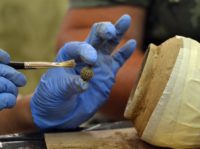 To all this political instability and conflict, the Tartar invasions added yet more. A chronicler of the late 14th century records how the Tartars invaded Varna in 1399. Other Black Sea coastal towns also suffered their wroth, Kaliakra among them. It’s possible that the hoard was actually buried by a Tartar, in fact. The objects appear to have been collected from different people in one event rather than accumulated by a single individual over time. The Tartars of Aktav held the fortress in 1401 when they were defeated and dispatched. As the house in which the treasure was buried is a high-end one, it’s conceivable that a Tartar commander sequestered it for himself and was living there when the 1401 attack drove him out and burned down his dwelling.
To all this political instability and conflict, the Tartar invasions added yet more. A chronicler of the late 14th century records how the Tartars invaded Varna in 1399. Other Black Sea coastal towns also suffered their wroth, Kaliakra among them. It’s possible that the hoard was actually buried by a Tartar, in fact. The objects appear to have been collected from different people in one event rather than accumulated by a single individual over time. The Tartars of Aktav held the fortress in 1401 when they were defeated and dispatched. As the house in which the treasure was buried is a high-end one, it’s conceivable that a Tartar commander sequestered it for himself and was living there when the 1401 attack drove him out and burned down his dwelling.
